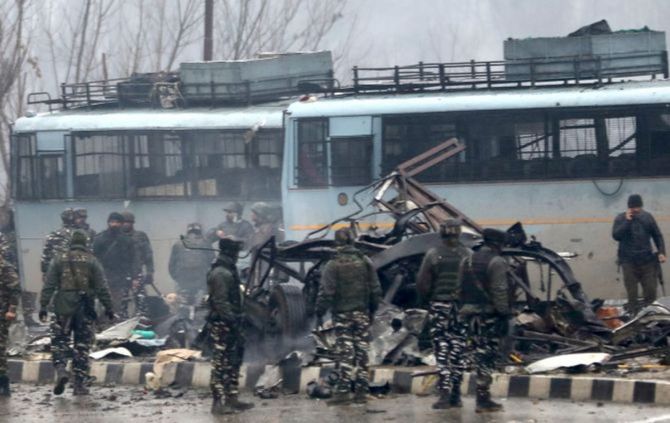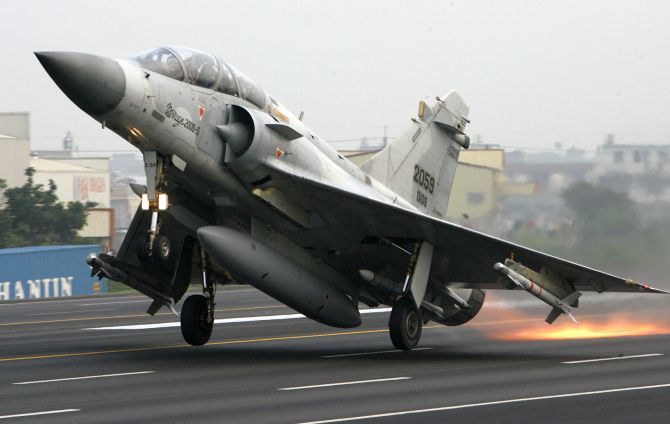'Jaish looked to creating regional mayhem, at a time when peace appeared more likely, and when that peace would have threatened Jaish's existence.'

In their latest book Spy Stories (Juggernaut), Adrian Levy and Cathy Scott-Clark reveal the cloak-and-dagger, hall of mirrors world that is spying in India and Pakistan, involving India's external intelligence agency, the Research and Analysis Wing -- RA&W -- and Pakistan's directorate of Inter Services Intelligence, the ISI.
In an e-mail conversation, Adrian Levy tells Rediff.com, "When Pulwama happened, the Pakistan military had a lot to lose having just been ushered into a new deal with the US and facing the wrath of money laundering authorities over its failure to reign in terror financing."
The final segment of a revealing four-part interview:
- Part I: 'ISI is rarely questioned in Pakistan'
- Part II: 'RA&W wins over Pakistan -- in the perception wars -- almost every year'
- Part III: The Importance of Ajit Doval
Even though you didn't get the Pulwama inquiry report from the Indian government and the internal report of the strike on Balakot from the Pakistan government what's your information of two events?
What was an extent of involvement of ISI in Pulwama? How lethal was the Indian strike in Balakot?
The evidence we have seen points to Jaish's role in Pulwama, and clearly depicts Masood Azhar's family as central to the attack.
But interestingly the evidence also suggests that the planning and training for the attack was done in Afghanistan -- in and around Helmand and Khost, to where much of Jaish had slipped.
Jaish by 2019 was an enemy of the Pakistan State having participated in multiple attacks on (then Pakistan president Pervez) Musharraf, GHQ (the Pakistan army headquarters in Rawalpindi), and the ISI -- officers and stations.
When Pulwama happened, the Pakistan military had a lot to lose having just been ushered into a new deal with the US and facing the wrath of money laundering authorities over its failure to reign in terror financing.
In this context, and as it had done in 2001 and 2008, Jaish looked to creating regional mayhem, at a time when peace appeared more likely, and when that peace would have threatened Jaish's existence.

To blame the ISI suited the Indian election cycle more than it fits with the available facts.
The same is true of Pathankot where the facts seen by us and the intel reporting blames Jaish and not ISI.
But if more evidence emerges that shows differently, we would report that too.
What the ISI and the (Pakistan) military has to answer for is the alacrity with which it has tackled its surrogates.
It took 18 years for Jaish to be substantially evicted while Masood Azhar remains free.
Lashkar was gradually tethered throughout Musharraf's period, as far as Kashmir went, only to re-emerge in Karachi and elsewhere before merging with al-Qaeda affiliates in the region but also in Turkey and Syria.
The internal war in Pakistan cost it tens of thousands of lives but has not been convincingly won, because these wars are hard to fight especially when, organisationally, not everyone remains committed to the same goal.
Which agency is closer to the CIA? R&AW or the ISI?
R&AW now is far closer. The ISI is deeply mistrusted (by the Americans), but, of necessity, needed.

Was it difficult to write a book on R&AW, an agency which is rarely talked about?
As a foreigner, how did you interview so many sleuths at the Intelligence Bureau and R&AW?
This is ongoing work and it has never been easy.
And even now, many of those who talked to us are uncomfortable with the claims made in the book.
Secrecy breads reticence, and there is no culture of open talking, only background briefing.
And we wanted to get away from that to bring their ideas into the open.
We greatly admire most of the people we talked to, but they might not like the book that resulted.
While reporting R&AW, what are the surprising and exclusive stories you got?
They are all in the book. Most disconcerting was the Kulbhushan Jadhav story -- a small fish, grown into a whale by Pakistan -- and who ultimately is a married man with kids who might not escape his fate.
Most enthralling was the R&AW campaign to portray ISI as the funder of 9/11 which it knew not to be true but worked hard to make seem right.
Most irritating was the Parliament attack where some of the sleuths became tarnished, mired in the mirror wars, and the protagonists emerge as, at best manipulated, and most likely sacrificed to the forever wars.
Feature Presentation: Aslam Hunani/Rediff.com









